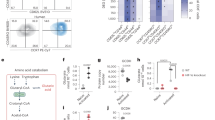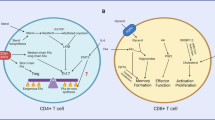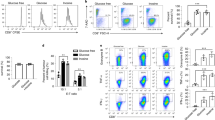Abstract
Current immunosuppressive therapies act on T lymphocytes by modulation of cytokine production, modulation of signaling pathways or by inhibition of the enzymes of nucleotide biosynthesis. We have identified a previously unknown series of immunomodulatory compounds that potently inhibit human and rat T lymphocyte proliferation in vitro and in vivo in immune-mediated animal models of disease, acting by a novel mechanism. Here we identify the target of these compounds, the monocarboxylate transporter MCT1 (SLC16A1)1, using a strategy of photoaffinity labeling and proteomic characterization. We show that inhibition of MCT1 during T lymphocyte activation results in selective and profound inhibition of the extremely rapid phase of T cell division essential for an effective immune response. MCT1 activity, however, is not required for many stages of lymphocyte activation, such as cytokine production, or for most normal physiological functions. By pursuing a chemistry-led target identification strategy, we have discovered that MCT1 is a previously unknown target for immunosuppressive therapy and have uncovered an unsuspected role for MCT1 in immune biology.
This is a preview of subscription content, access via your institution
Access options
Subscribe to this journal
Receive 12 print issues and online access
$259.00 per year
only $21.58 per issue
Buy this article
- Purchase on Springer Link
- Instant access to full article PDF
Prices may be subject to local taxes which are calculated during checkout




Similar content being viewed by others
References
Halestrap, A.P. & Meredith, D. The SLC16 gene family - from monocarboxylate transporters (MCTs) to aromatic amino acid transporters and beyond. Pflugers Arch. 447, 619–628 (2004).
Michne, W.F. et al. Novel inhibitors of the nuclear factor of activated T cells (NFAT)-mediated transcription of β-galactosidase: potential immunosuppressive and antiinflammatory agents. J. Med. Chem. 38, 2557–2569 (1995).
Cheshire, D. et al. Novel compounds. Patent WO9854190. (1998).
Bantick, J.R., Cooper, M.E., Thorne, P. & Perry, M.W.D. Novel compounds. Patent WO9929695. (1999).
Ford, W.L., Burr, W. & Simonsen, M. A lymph node weight assay for the graft-versus-host activity of rat lymphoid cells. Transplantation 10, 258–266 (1970).
Larsson, P., Kleinau, S., Holmdahl, R. & Klareskog, L. Homologous type II collagen-induced arthritis in rats. Arthritis Rheum. 33, 693–701 (1990).
Baine, Y. et al. Functional characterization of novel IL-2 transcriptional inhibitors. J. Immunol. 154, 3667–3677 (1995).
Mempel, T.R., Henrickson, S.E. & von Andrian, U.H. T-cell priming by dendritic cells in lymph nodes occurs in three distinct phases. Nature 427, 154–159 (2004).
Poole, R.C., Sansom, C.E. & Halestrap, A.P. Studies on the membrane topology of the rat erythrocyte H+/lactate cotransporter (MCT1). Biochem. J. 320, 817–824 (1996).
Ishihara, H., Wang, H., Drewes, L.R. & Wollheim, C.B. Overexpression of monocarboxylate transporter and lactate dehydrogenase alters insulin secretory responses to pyruvate and lactate in β cells. J. Clin. Invest. 104, 1621–1629 (1999).
Wang, X., Levi, A.J. & Halestrap, A.P. Kinetics of the sarcolemmal lactate carrier in single heart cells using BCECF to measure pHi . Am. J. Physiol. 267, H1759–H1769 (1994).
Halestrap, A.P. & Price, N.T. The proton-linked monocarboxylate transporter (MCT) family: structure, function and regulation. Biochem. J. 343, 281–299 (1999).
Guppy, M., Greiner, E. & Brand, K. The role of the Crabtree effect and an endogenous fuel in the energy metabolism of resting and proliferating thymocytes. Eur. J. Biochem. 212, 95–99 (1993).
Bental, M. & Deutsch, C. Metabolic changes in activated T cells: an NMR study of human peripheral blood lymphocytes. Magn. Reson. Med. 29, 317–326 (1993).
Frauwirth, K.A. et al. The CD28 signaling pathway regulates glucose metabolism. Immunity 16, 769–777 (2002).
Wilson, M.C. et al. Lactic acid efflux from white skeletal muscle is catalyzed by the monocarboxylate transporter isoform MCT3. J. Biol. Chem. 273, 15920–15926 (1998).
Dimmer, K-S., Friedrich, B., Lang, F., Deitmer, J.W. & Broer, S. The low-affinity monocarboxylate transporter MCT4 is adapted to the export of lactate in highly glycolytic cells. Biochem. J. 350, 219–227 (2000).
Manning Fox, J.E., Meredith, D. & Halestrap, A.P. Characterisation of human monocarboxylate transporter 4 substantiates its role in lactic acid efflux from skeletal muscle. J. Physiol. (Lond.) 529, 285–293 (2000).
Lee, W.-N.P. et al. Mass isotopomer study of the nonoxidative pathways of the pentose cycle with [1,2-13C2]glucose. Am. J. Physiol. 274, E843–E851 (1998).
Buttgereit, F. & Brand, M.D. A hierarchy of ATP-consuming processes in mammalian cells. Biochem. J. 312, 163–167 (1995).
Fairbanks, L.D., Bofill, M., Ruckemann, K. & Simmonds, H.A. Importance of ribonucleotide availability to proliferating T-lymphocytes from healthy humans. Disproportionate expansion of pyrimidine pools and contrasting effects of de novo synthesis inhibitors. J. Biol. Chem. 270, 29682–29689 (1995).
Frauwirth, K.A. & Thompson, C.B. Regulation of T-lymphocyte metabolism. J. Immunol. 172, 4661–4665 (2004).
Bental, M. & Deutsch, C. 19F-NMR study of primary human T lymphocyte activation: effects of mitogen on intracellular pH. Am. J. Physiol. 266, C541–C551 (1994).
Daberkow, R.L., White, B.R., Cederberg, R.A., Griffin, J.B. & Zempleni, J. Monocarboxylate transporter 1 mediates biotin uptake in human peripheral blood mononuclear cells. J. Nutr. 133, 2703–2706 (2003).
Dröge, W., Roth, S., Altmann, A. & Mihm, S. Regulation of T-cell functions by L-lactate. Cell. Immunol. 108, 405–416 (1987).
Roth, S. & Dröge, W. Regulation of interleukin 2 production, interleukin 2 mRNA expression and intracellular glutathione levels in ex vivo derived T lymphocytes by lactate. Eur. J. Immunol. 21, 1933–1937 (1991).
Kirk, P. et al. CD147 is tightly associated with lactate transporters MCT1 and MCT4 and facilitates their cell surface expression. EMBO J. 19, 3896–3904 (2000).
Renno, T. et al. A role for CD147 in thymic development. J. Immunol. 168, 4946–4950 (2002).
Staffler, G. et al. Selective inhibition of T cell activation via CD147 through novel modulation of lipid rafts. J. Immunol. 171, 1707–1714 (2003).
Acknowledgements
We thank A. Baines for helpful advice on protein purification from red blood cells and K. Wood, D. Cantrell and A. Halestrap for helpful advice and discussions. We thank K. Jolley for technical assistance in analyzing glucose metabolites by GC-MS, E. Newboult and S. Cartlidge for tumor cell proliferation studies and M. Erlansson and L. Jansson for the CIA model. We gratefully acknowledge the assistance of S. Guile and R. Mohammed in collating the chemical synthesis and analysis information.
Author information
Authors and Affiliations
Corresponding author
Ethics declarations
Competing interests
The authors are either current or former employees of Astra Zeneca p/c.
Supplementary information
Supplementary Fig. 1
Effects of novel immunomodulators on in vitro human T-lymphocyte responses. (PDF 178 kb)
Supplementary Fig. 2
Effect of MCT1 inhibitors on the intracellular pH of human T-lymphocytes. (PDF 22 kb)
Supplementary Table 1
Chemical structures and names. (PDF 10 kb)
Supplementary Table 2
Effect of compound 1 on proliferation of human cells. (PDF 19 kb)
Supplementary Table 3
Correlation between compound binding to Jurkat T-cells and MCT1 and inhibition of PBMC proliferation. (PDF 20 kb)
Supplementary Table 4
Correlation between compound effects on lactate levels, DNA synthesis and inhibition of proliferation in human T-cells. (PDF 19 kb)
Rights and permissions
About this article
Cite this article
Murray, C., Hutchinson, R., Bantick, J. et al. Monocarboxylate transporter MCT1 is a target for immunosuppression. Nat Chem Biol 1, 371–376 (2005). https://doi.org/10.1038/nchembio744
Received:
Accepted:
Published:
Issue Date:
DOI: https://doi.org/10.1038/nchembio744
This article is cited by
-
PPAR-γ regulates the effector function of human T helper 9 cells by promoting glycolysis
Nature Communications (2023)
-
Nanosystem-mediated lactate modulation in the tumor micro environment for enhanced cancer therapy
Nano Research (2023)
-
Participation of protein metabolism in cancer progression and its potential targeting for the management of cancer
Amino Acids (2023)
-
Myeloid-derived suppressor cells impair CD4+ T cell responses during chronic Staphylococcus aureus infection via lactate metabolism
Cellular and Molecular Life Sciences (2023)
-
Targeting cancer metabolism in the era of precision oncology
Nature Reviews Drug Discovery (2022)



